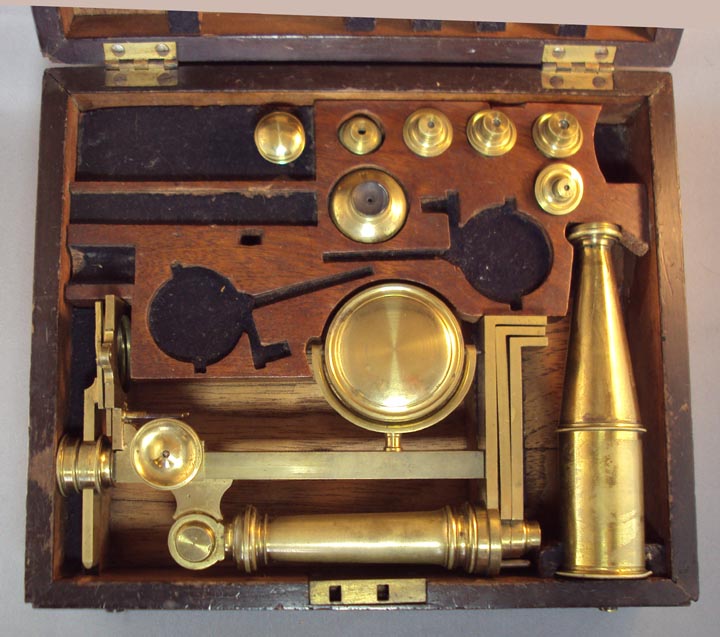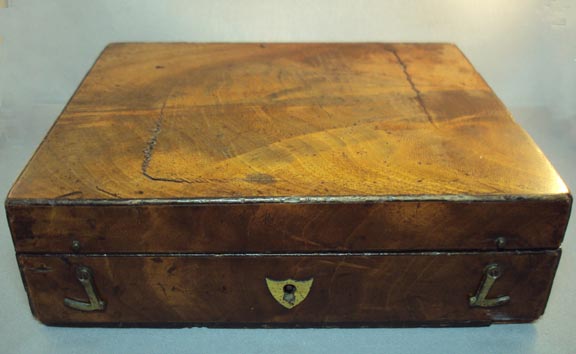MICROSCOPE-ANTIQUES.COM © 2013-15.
JONES MOST IMPROVED-TYPE MICROSCOPE:
c. 1830
SIGNED: 'Elliot 227 High Holborn London'
Serial Number: None
DESCRIPTION
 Signed: 'WM Elliot 227 High Holborn London' on one of the 3 folding feet. The optical tube barrel has a tapered snout.
There is rack and pinion focusing to the stage, and aquatic motion to the arm, the forward-backward motion
having its tension adjustable by a round pressure-fitting. The stage has holes, one on each
side, to accept stage forceps, bullseye condenser, or other
similarly supported accessories. There are seven objectives, one of which is a Lieberkuhn; one objective with a screw-on cap is labelled inside the cap as '1/30.'
This degree of magnification with an non-achromatic system would be almost meaningless, revealing more artifact than facts.
The stage has a U-shaped fitting on pins which fit through the stage; this would hold slides or other items on the stage. The substage mirror is on
a gimbal but fixed in position otherwise. The original case has a veneered exterior.
There is a square-shaped crack in the top of the case which overlies a similarly shaped
piece of wood in the inside of the lid. The lock has a shield-shaped escutcheon.
The catches which hold the box closed are made of thick brass.
Signed: 'WM Elliot 227 High Holborn London' on one of the 3 folding feet. The optical tube barrel has a tapered snout.
There is rack and pinion focusing to the stage, and aquatic motion to the arm, the forward-backward motion
having its tension adjustable by a round pressure-fitting. The stage has holes, one on each
side, to accept stage forceps, bullseye condenser, or other
similarly supported accessories. There are seven objectives, one of which is a Lieberkuhn; one objective with a screw-on cap is labelled inside the cap as '1/30.'
This degree of magnification with an non-achromatic system would be almost meaningless, revealing more artifact than facts.
The stage has a U-shaped fitting on pins which fit through the stage; this would hold slides or other items on the stage. The substage mirror is on
a gimbal but fixed in position otherwise. The original case has a veneered exterior.
There is a square-shaped crack in the top of the case which overlies a similarly shaped
piece of wood in the inside of the lid. The lock has a shield-shaped escutcheon.
The catches which hold the box closed are made of thick brass.
HISTORY OF THE (W & S) JONES MOST-IMPROVED TYPE MICROSCOPE
 William and Samuel Jones became famous instrument makers of the early nineteenth century. Among their
microscopes were simple botanical microscopes as well as more complex instruments.
George Adams Jr devised his 'Universal Compound Microscope' from which the 'Jones Most Improved' was clearly derived.
After devising the 'Jones Improved' microscope, W & S Jones then came out with the 'Jones Most-Improved' Microscope.
It was sold in two sizes and
this is the smaller version. In larger versions the mirror assembly could slide up or down, and other embellishments
might include a rack and pinion forward and backward motion to the arm, and a crude substage condenser. Some models had a
rotating wheel of objectives. It was a standard microscope of the preachromatic era, and even beyond, as in
some cases they were adapted for achromatic objectives. Although an improvement over flimsier designs, this was still
not the best design for critical high power work with achromatic optics however, and
soon was replaced by Lister-limb and Bar-limb microscopes. William Elliot operated at this particular
address for only a short time.
William and Samuel Jones became famous instrument makers of the early nineteenth century. Among their
microscopes were simple botanical microscopes as well as more complex instruments.
George Adams Jr devised his 'Universal Compound Microscope' from which the 'Jones Most Improved' was clearly derived.
After devising the 'Jones Improved' microscope, W & S Jones then came out with the 'Jones Most-Improved' Microscope.
It was sold in two sizes and
this is the smaller version. In larger versions the mirror assembly could slide up or down, and other embellishments
might include a rack and pinion forward and backward motion to the arm, and a crude substage condenser. Some models had a
rotating wheel of objectives. It was a standard microscope of the preachromatic era, and even beyond, as in
some cases they were adapted for achromatic objectives. Although an improvement over flimsier designs, this was still
not the best design for critical high power work with achromatic optics however, and
soon was replaced by Lister-limb and Bar-limb microscopes. William Elliot operated at this particular
address for only a short time.
 Signed: 'WM Elliot 227 High Holborn London' on one of the 3 folding feet. The optical tube barrel has a tapered snout.
There is rack and pinion focusing to the stage, and aquatic motion to the arm, the forward-backward motion
having its tension adjustable by a round pressure-fitting. The stage has holes, one on each
side, to accept stage forceps, bullseye condenser, or other
similarly supported accessories. There are seven objectives, one of which is a Lieberkuhn; one objective with a screw-on cap is labelled inside the cap as '1/30.'
This degree of magnification with an non-achromatic system would be almost meaningless, revealing more artifact than facts.
The stage has a U-shaped fitting on pins which fit through the stage; this would hold slides or other items on the stage. The substage mirror is on
a gimbal but fixed in position otherwise. The original case has a veneered exterior.
There is a square-shaped crack in the top of the case which overlies a similarly shaped
piece of wood in the inside of the lid. The lock has a shield-shaped escutcheon.
The catches which hold the box closed are made of thick brass.
Signed: 'WM Elliot 227 High Holborn London' on one of the 3 folding feet. The optical tube barrel has a tapered snout.
There is rack and pinion focusing to the stage, and aquatic motion to the arm, the forward-backward motion
having its tension adjustable by a round pressure-fitting. The stage has holes, one on each
side, to accept stage forceps, bullseye condenser, or other
similarly supported accessories. There are seven objectives, one of which is a Lieberkuhn; one objective with a screw-on cap is labelled inside the cap as '1/30.'
This degree of magnification with an non-achromatic system would be almost meaningless, revealing more artifact than facts.
The stage has a U-shaped fitting on pins which fit through the stage; this would hold slides or other items on the stage. The substage mirror is on
a gimbal but fixed in position otherwise. The original case has a veneered exterior.
There is a square-shaped crack in the top of the case which overlies a similarly shaped
piece of wood in the inside of the lid. The lock has a shield-shaped escutcheon.
The catches which hold the box closed are made of thick brass. William and Samuel Jones became famous instrument makers of the early nineteenth century. Among their
microscopes were simple botanical microscopes as well as more complex instruments.
George Adams Jr devised his 'Universal Compound Microscope' from which the 'Jones Most Improved' was clearly derived.
After devising the 'Jones Improved' microscope, W & S Jones then came out with the 'Jones Most-Improved' Microscope.
It was sold in two sizes and
this is the smaller version. In larger versions the mirror assembly could slide up or down, and other embellishments
might include a rack and pinion forward and backward motion to the arm, and a crude substage condenser. Some models had a
rotating wheel of objectives. It was a standard microscope of the preachromatic era, and even beyond, as in
some cases they were adapted for achromatic objectives. Although an improvement over flimsier designs, this was still
not the best design for critical high power work with achromatic optics however, and
soon was replaced by Lister-limb and Bar-limb microscopes. William Elliot operated at this particular
address for only a short time.
William and Samuel Jones became famous instrument makers of the early nineteenth century. Among their
microscopes were simple botanical microscopes as well as more complex instruments.
George Adams Jr devised his 'Universal Compound Microscope' from which the 'Jones Most Improved' was clearly derived.
After devising the 'Jones Improved' microscope, W & S Jones then came out with the 'Jones Most-Improved' Microscope.
It was sold in two sizes and
this is the smaller version. In larger versions the mirror assembly could slide up or down, and other embellishments
might include a rack and pinion forward and backward motion to the arm, and a crude substage condenser. Some models had a
rotating wheel of objectives. It was a standard microscope of the preachromatic era, and even beyond, as in
some cases they were adapted for achromatic objectives. Although an improvement over flimsier designs, this was still
not the best design for critical high power work with achromatic optics however, and
soon was replaced by Lister-limb and Bar-limb microscopes. William Elliot operated at this particular
address for only a short time.